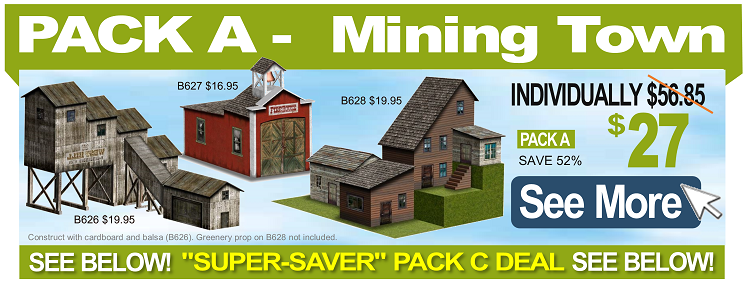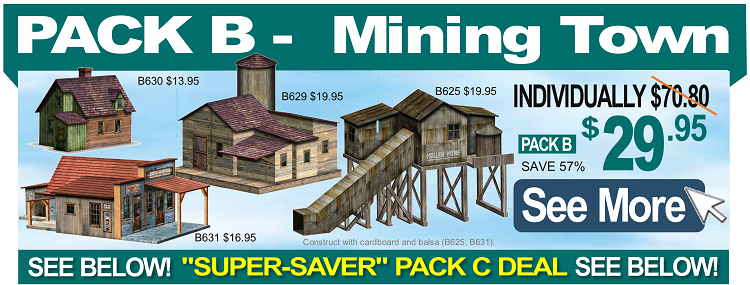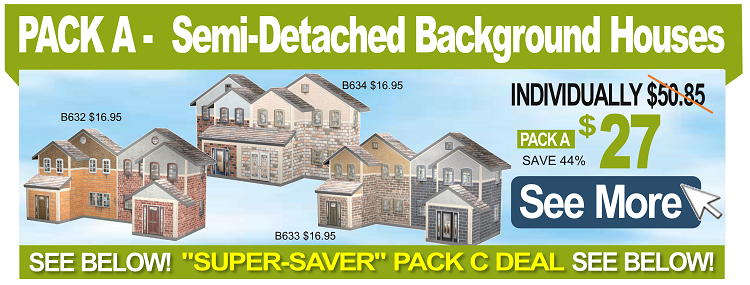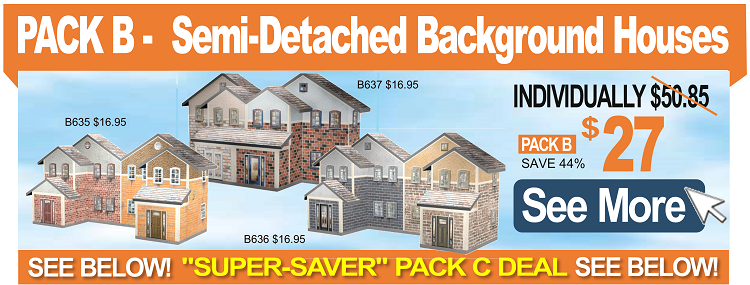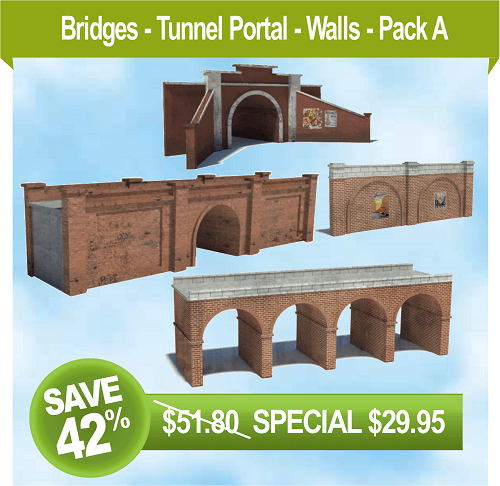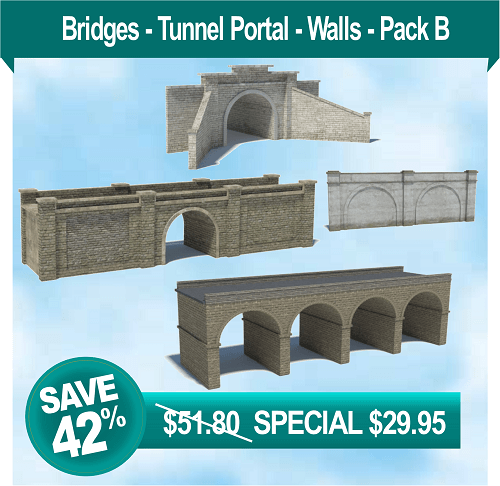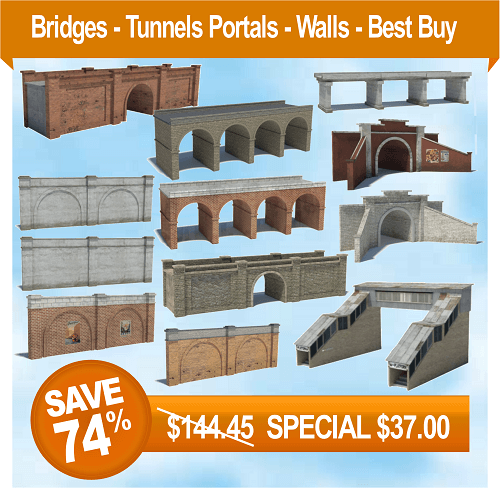Printable Models: N Scale, OO, HO Scale Model Railroad Bridges, Train Tunnels, and Brick Walls. Download, Print, and Build
-
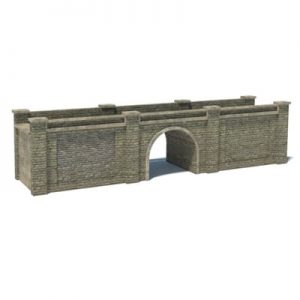
Arch Bridge (gray brick, center arch)
$12.95 -
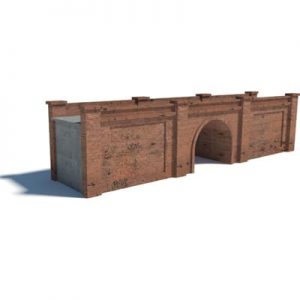
Arch Bridge (red brick, center arch)
$12.95 -
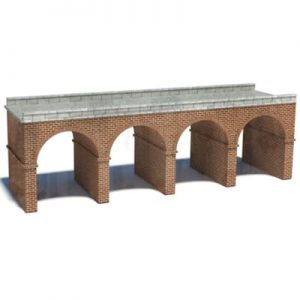
Arched Bridge (brown brick, 4 arches)
$12.95 -
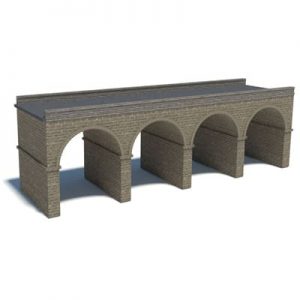
Arched Bridge (gray brick, 4 arches)
$12.95 -
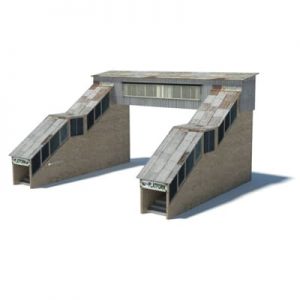
Pedestrian Overpass
$14.95 -
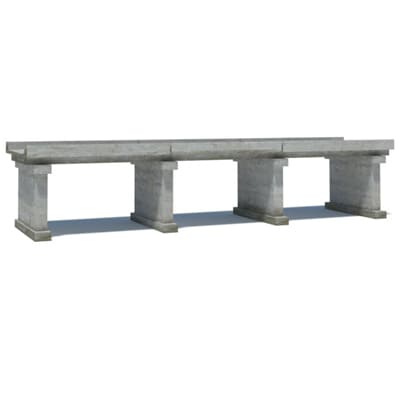
Road Flyover
$12.95 -
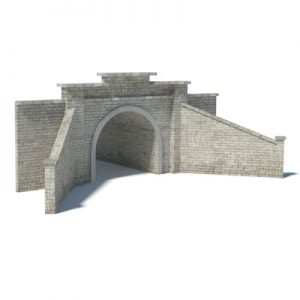
Tunnel Portal (gray brick)
$12.95 -
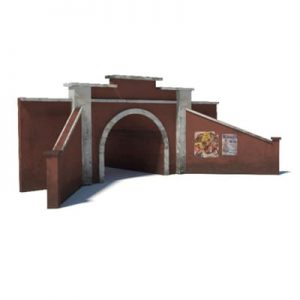
Tunnel Portal (red brick)
$12.95 -
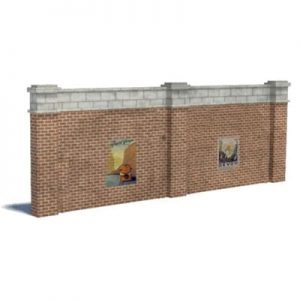
Wall (brown brick, 1 arched, 1 plain)
$12.95 -
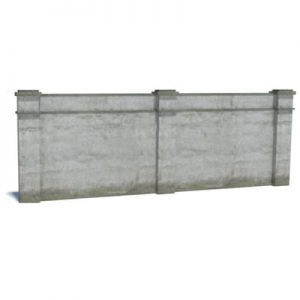
Wall (gray brick, 1 arched, 1 plain)
$12.95 -
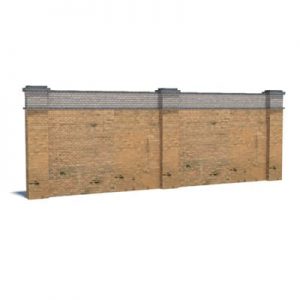
Wall (tan brick, 1 arched, 1 plain)
$12.95
You can download these scale model paper plans almost instantly and save them to your computer for future use. The printable plans are downloaded in the easy to use PDF format and can be printed to HO scale, or to N scale, or OO scale. You just select from the options at the checkout when buying your downloads.
Downloading These Papers Plans For Scale Model Walls, Tunnel Portals, and Model Railroad Bridges Is Quick & Easy!
The plans you see here on this web page download complete with photo-realistic patterns, weathering and detailing. You print the downloads onto photocopy paper and glue the printed sheets to cardboard (a cereal box will do), or to corflute – that’s the material real estate signs are made from and its very cheap to buy at a hardware store or discounter.
For example; plan number B552 is a brick wall design. Viewed up close, it is hard to pick the scaled to size replica from the prototypical “life-sized” brick wall it was modelled on. The detailing is done to a very high quality to please the most discerning model railroader.
[expander_maker id=”1″ more=”Load more” less=”Load less”]Fact is; if you were to construct a similar long wall using plastic model kits, it would cost you a small fortune… and that’s not even allowing for the cost of paints and airbrushing to hide the plastic look.
In comparison, you can download these PDF paper plans JUST ONCE … and, you can then print out as many duplicates as you might need for your brick wall to stretch the distance you want. The only restriction is that they must be solely for your own personal and private usage; and not for commercial use because they are protected by International Copyright Laws. Paper plans for the model railroad bridges, tunnel portals, and scale model walls can be printed in HO scale, or if you model N scale, or OO gauge you can print the paper plans to those sizes too.
Printing & Construction Tips for Making Tunnel Portals, Model Railroad Bridges, and Scale Model Walls on a Railway Layout
It’s over to you what construction method you use. The plans for the various paper models can be glued onto card, or corflute sheeting (cheap to buy from DIY and Discount stores)…so you can construct these printable scale models to be as strong as you require.
Some people like to glue a first copy onto card, cut out the scale model wall arches, and glue another copy onto card for positioning in or behind the arch (to give an even deeper 3D effect). The plans are very versatile so you can do it any way you want.
Constructing Your Own Scale Model Railroad Walls
Whether you position scale model brick walls against a background, or forming part of a model railroad bridge structure, or simply as an ingenious visual transition between the levels on your layout… there’s no doubting they can make for a remarkably realistic miniature scene. Brick walls, and especially arched brick walls, will contribute real significance and character to any model railroad scene.
Better yet… these arched brick scale model walls and bridges are inexpensive and a lot of fun to make.
> Walls will not only provide extra height to your layout, but will also provide an excellent transition to an upper level.
> Scale model walls can be used directly against backdrops and can also be joined onto an arched road or a model railroad bridge.
> And, brick walls can be a great place to include extra detailing such as some advertising posters, and maybe a little graffiti for even more realism.
The brick walls you construct should turn out to very impressive, but unfortunately are unlikely to become as famous as these:
The World’s Most Famous Walls
1. The Great Wall of China
2. Berlin Wall (Germany)
3. Walls of Troy (Turkey)
4. The Western Wall – Wailing Wall (Israel)
5. Walls of Babylon (Iraq)
6. Hadrian’s Wall (UK)
7. Great Zimbabwe Walls (Zimbabwe)
8. Walls of Ston (Croatia)
9. Sacsayhuaman (Peru)
10. Diyarbakir Walls (Turkey)
Constructing Your Own Model Railroad Tunnel Portals
Tunnels are the perfect feature for making your scale model railroad look considerably bigger than it actually is. Model trains can disappear into a tunnel portal before, almost as if magically, reappearing out the opposite end. A tunnel can hide trains for a short spell of time, allowing the observer to imagine that they have left the region for a destination further away.
From my own experience, it’s generally best to construct the tunnels during the early stages of building a model railroad layout. If you wait until the scenery is completed, it can be very difficult to include a tunnel without upsetting the scenery you have in place.
The most realistic tunnels are type you construct yourself… and the most visible part of a tunnel is the tunnel portal where trains enter and exit. The portal plans on this website can be made as double (for two tracks) or single (for one track) portals.
And, there are various ways to go about it.
One option is to make your own plaster or resin cast to form the tunnel shape.
Another method is to cut and build the tunnel walls and roof from Styrofoam that comes in boxes as packing material. You then add newspaper to create the mountain over the Styrofoam tunnel, which you can then cover with plastercloth before painting.
A third method is weave a cardboard web to form the sides and top of the tunnel, and cover this with wadded newspaper and then plastercloth to finish the mountain form.
Perhaps the most popular material these days for tunnel construction is extruded foam, which is sold at DIY stores for insulating houses. It’s popular because, the foam can be easily cut and shaped to how you want.
And, some modellers even make tunnels out of heavy duty disposable food trays. So, there’s plenty of options.
But no tunnel is complete without tunnel portals. Again you can buy the plastic variety which requires painting and airbrushing to make them look more real, or you can make your own from downloadable, photo-realistic, printable paper plans that are already weathered and detailed. These look very realistic and are really versatile, but it’s really up to you. These paper models can be printed to Ho scale or other scales such as OO gauge and N scale. For HO scale go to the checkout and select OO / HO scale. The plans can then be downloaded and printed to OO scale, or using your desktop printer simply alter the print settings to 87 percent for HO scale. Choosing N scale at the checkout means you can download the paper models exactly to N scale.
I mentioned versatility. With this plan you can extend the walls to the sides, and/or add wall wings like this. Because you make these tunnel portals yourself, you can have it any way you want, and use any material you want… cardboard, corflute, balsa, foam board… you decide.
Have fun making your tunnel portals, scale model walls and bridges.
Construct Beam Bridges On Your Scale Model Railroad Layout
Railroads love cheap and easy. The number of beam bridges on prototypical railroads is proof of that concept. Every railroad that has to span a few tens of feet of open space has them, and they have been around almost as long as railroads have existed.
A beam bridge is just what its name implies. Several large weight bearing beams span the gap, and cross members join the beams together and support the track. Beam bridges come in all lengths from a single span over a street or road to multiple spans with concrete or steel piers supporting the beams across hundreds of feet.
Model Kitset Bridges
There are many model companies (Walthers, Atlas, Bachmann) that offer beam bridge kits. They can be easily assembled in an hour or two, and a short span is relatively easy to include in a train layout. Preparation for the bridge usually involves the removal of a short section of train track and scenery at some point that makes sense on your layout. If you haven’t included the physical feature like a creek or ditch to span, you should also plan to do that work at the same time you do the track removal. You needn’t finish all the scenery around the bridge right away, but completing the parts that would be hard to do with the bridge in place is certainly the way to go. Once your terrain work is finished, you can place the bridge and reinstall the track. Add guard rails and complete the scenery work around the bridge to finish off the project.
Scratch Building Bridges
Building a beam bridge from scratch is also an option, and an ideal way to break into the whole scratch building world. Model-size stripwood is available from a number of sources, and if you are modeling a late 19th century scene, a wooden beam bridge will be the only choice. Wood is easy to work with and will take practically any stain or weathering you care to put on it. Wood will need weathering to appear realistic, so a photo trip might be in order. You might not have a wooden trestle or bridge nearby, however the ubiquitous wooden telephone or power line pole will have use the same kind of preservatives and will have a similar appearance to wooden railroad structures.
Wooden beam bridges are built much like trestles, but usually only have one bent on each end of the span. If you are planning to build a wooden beam bridge from scratch, or think you might be interested in adding a trestle at some point, a jig will help immensely in constructing a set of bents.
Steel beam bridges came into wide use in the early part of the 20th century and continue to be built and put into service today. Modeling a modern beam bridge is easy, as there is a wide variety of scale sized plastic shapes for modeling available from companies like Evergreen, Plastruct and Knightwing. Search the internet or the hobby shop where you buy model train supplies for ideas.
As common as beam bridges are nowadays, it should be easy to find one locally to photograph for construction details. There are hundreds of modern and historical pictures of prototypical railroad beam bridges on the Internet as well, so making a plan or template for one should be straightforward.
Stratch built model railroad buildings and fun and easy to make from paper, cardboard, or foam board. Many model railway building kits come in plastic (they are expensive and still need painting and weathering after assembly), or you can buy model railroad buildings as printable downloads. When constructed from card (or foam board) they are extremely sturdy and durable. They don’t need painting or weathering because that’s already done (to a high standard) for you. Construction is fun and they are a fraction of what they would cost if they were made from plastic kits.
[/expander_maker]

